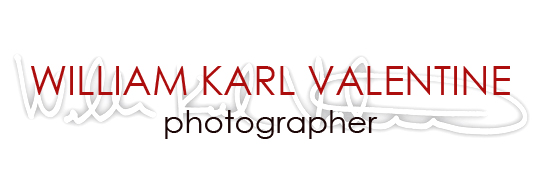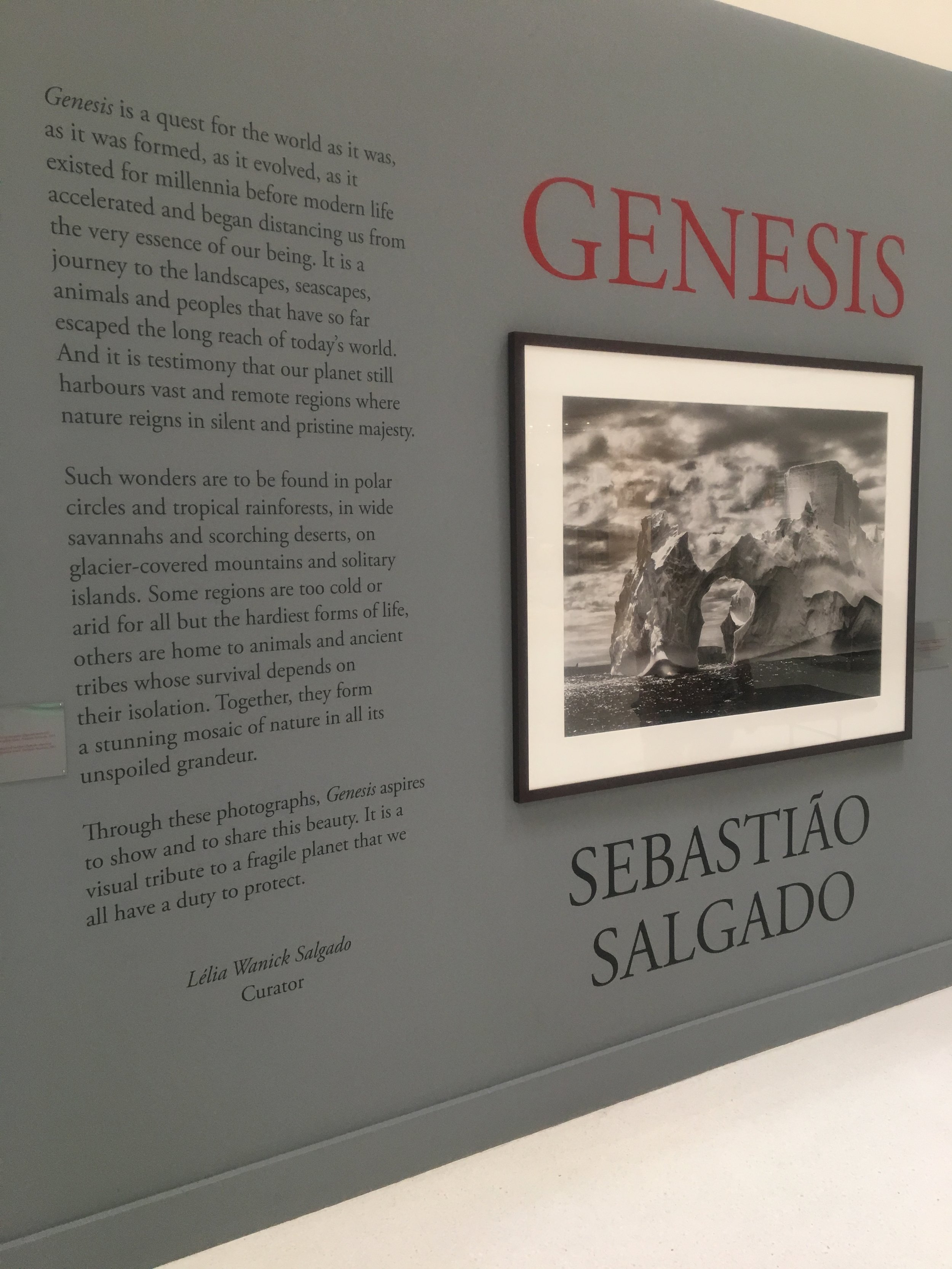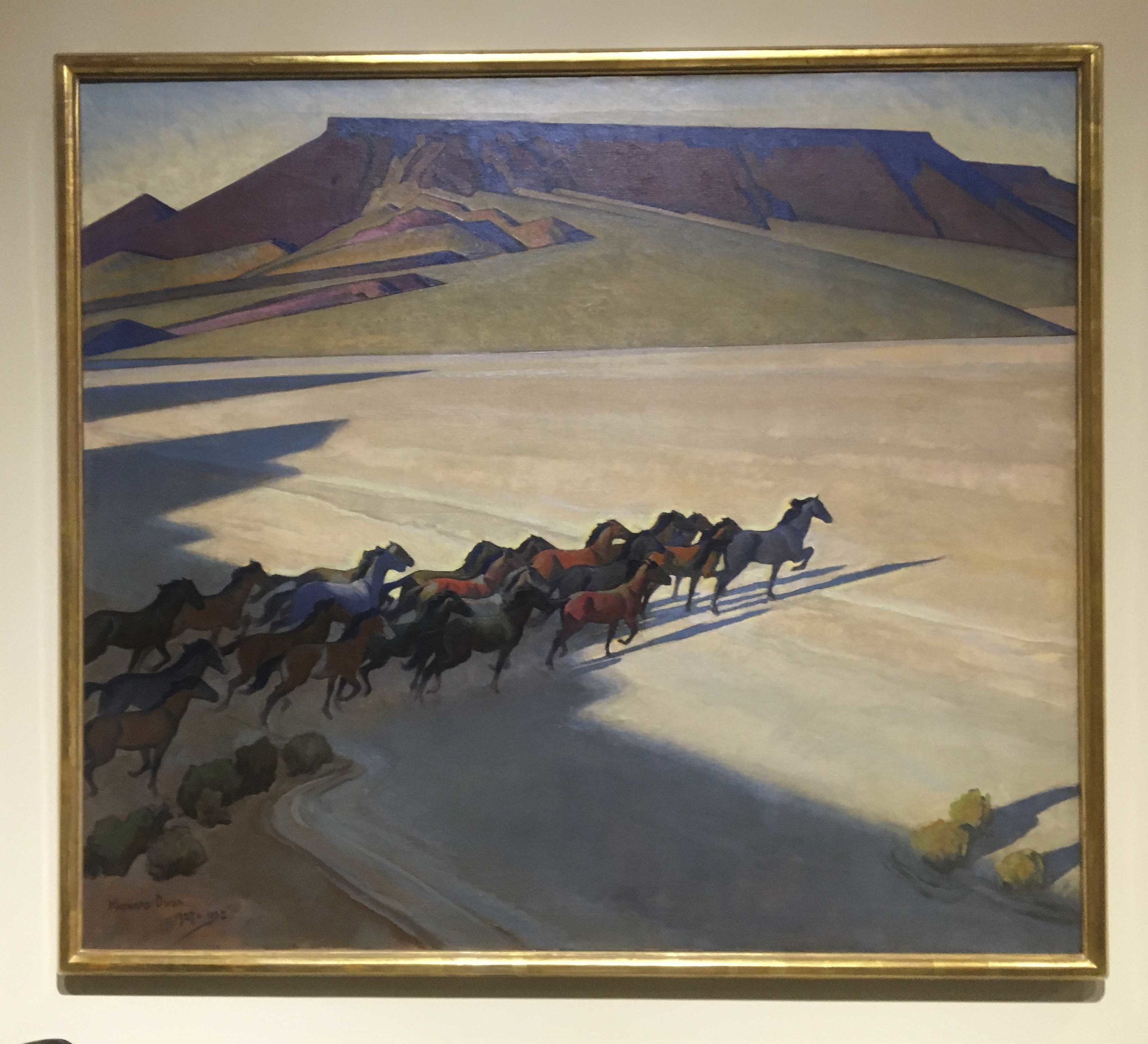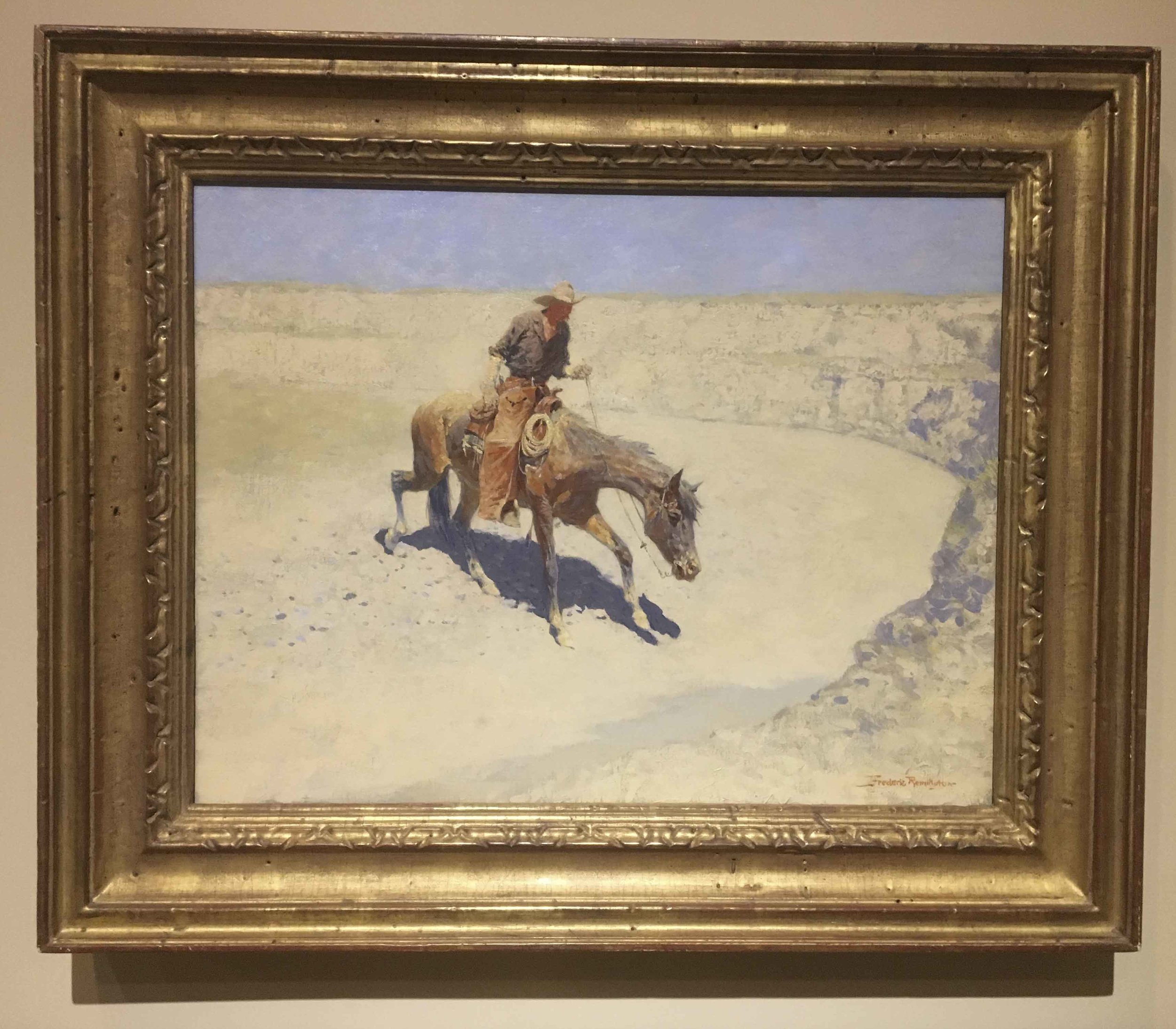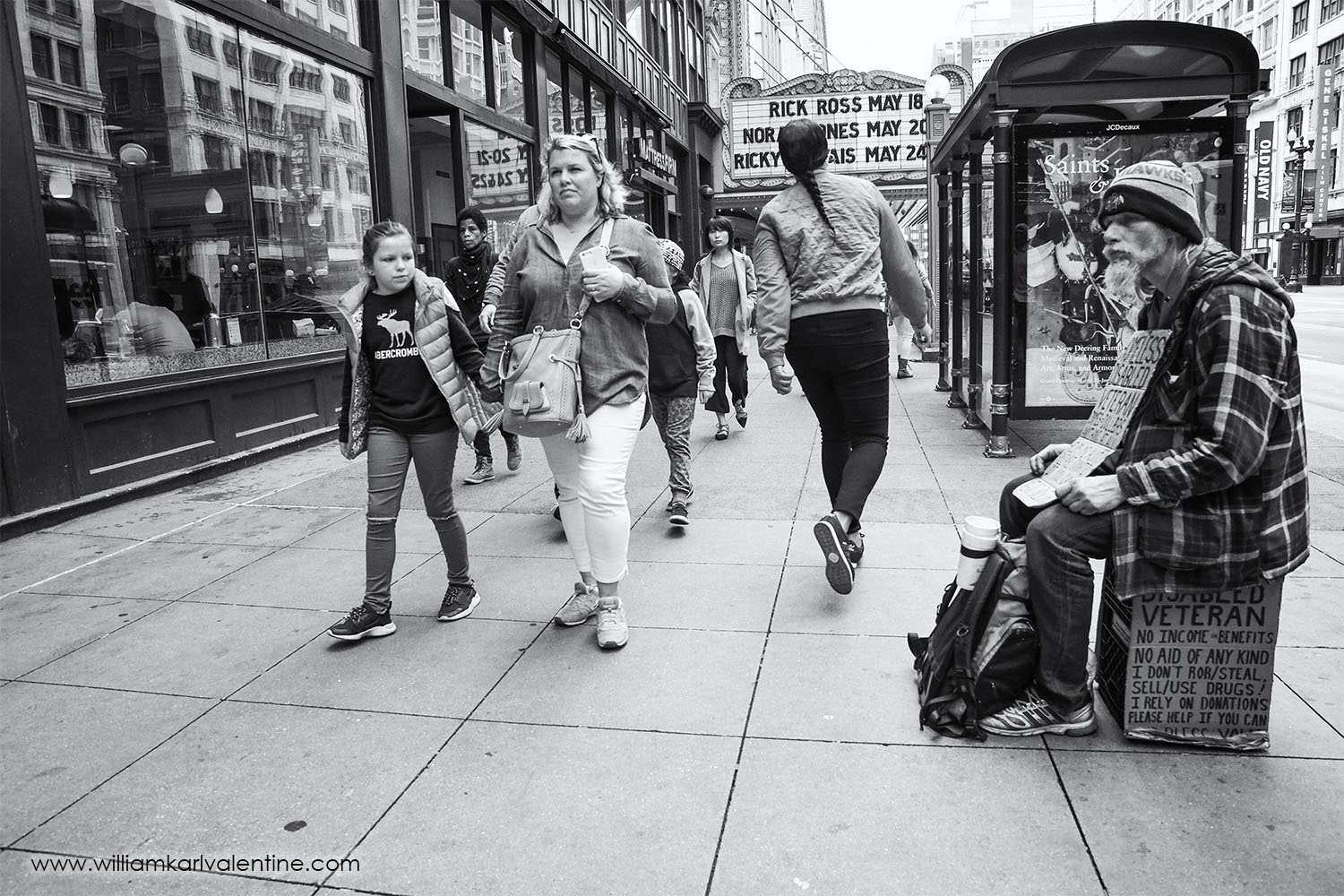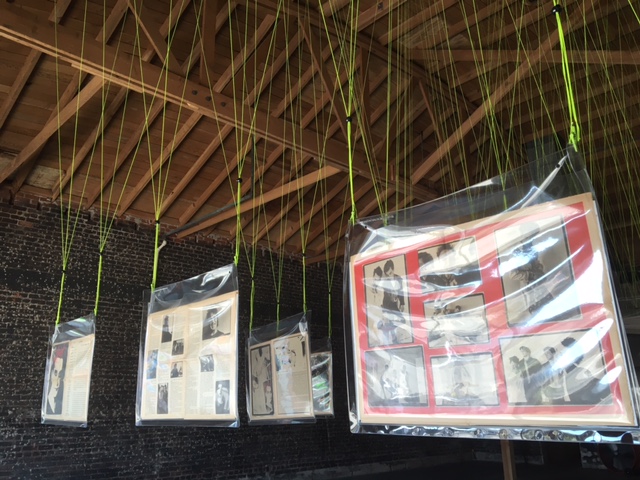William Karl Valentine's review, and images, of Pier 24 Gallery's exhibition "The Grain of the Present"
Read MoreMoPA - Sebastiao Salgado exhibition
The Sebastião Salgado "Genesis" exhibition at MoPA in San Diego is wrapping up this weekend, luckily I was able to get to see it earlier this month. I am a huge fan of MoPA, and a member. Its a great space, always worth the trek south, and this was another solid exhibition.
I had seen silver prints from Sebastião Salgado's Workers series before and was impressed. I am pretty sure this is the first time I have seen prints from the Genesis series. All the prints at MoPA were digital prints either from original digital files or scanned negatives. The massive scale is impressive and appropriate for the subject matter. The quality of most of the prints were very good. I think MoPA did an outstanding job getting so much work up without it feeling crowded.
The The International Center of Photography was the first venue in the United States to host this exhibition in 2014 which was curated by Lélia Wanick Salgado. The ICP described the exhibition this way: "Genesis is the third long-term series on global issues by world-renowned photographer Sebastião Salgado (born Brazil, 1944), following Workers(1993) and Migrations (2000). The result of an eight-year worldwide survey, the exhibition draws together more than 200 spectacular black and white photographs of wildlife, landscapes, seascapes, and indigenous peoples—raising public awareness about the pressing issues of environment and climate change." A powerful body of work, relevant to today, and well worth the view.
Artmoi used my billboard on their feature about the 2016 Billboard Creative in Los Angeles
The Billboard Creative 2016 - Los Angeles
In December 2016 I had an image included in a very unique exhibition here in Los Angeles, The Billboard Creative. The exhibition takes unsold billboard spaces and features one artist, and one of their works, on each billboard for a month in December. My billboard was on Wilshire Boulevard and Dunsmuir Avenue just east of LACMA.
I am always happy to have my work seen, but I especially happy that Mona Kuhn included this image in the group of 45 selected artworks for the 2016 Billboard Creative. I love the concept of putting artwork on billboards in a place like Los Angeles which is such a car centered society. I also felt this was the perfect image for the venue and I get excited to think of the thousands of people who had a chance to see one of my most important photographs.
I also love the fact this image was displayed over a Thai Massage parlor!
HAFNY.org also used my image as the lead image to their feature on the project.
http://www.thebillboardcreative.com/gallery-1/#2016-show2
http://hafny.org/blog/2016/12/the-billboard-creative-turns-los-angeles-empty-ad-space-into-public-art
2017 Los Angeles Exhibitions - Bowers & Autry
This past year the Autry Museum in Los Angeles and the Bowers Museum in Santa Ana both had exhibitions of some amazing photographs by the masters. Bowers had its final exhibition in a series on Edward Weston's work and the Autry highlighted Group f/64 and Richard Misrach's photographs from the Bank of America collection. I believe it so important to see prints by the masters of our craft for a photographer to really have the understanding of what a good print looks like. I remember early in my career getting to see, and hold, a Weston pepper print and learning so much from that experience. Another important exhibition I saw was SFMOMA commemoration of the 100th anniversary of the birth of Ansel Adams where they exhibited 100 of his prints curated by John Szarkowski. What I enjoyed most in that exhibition was seeing prints of the same image that were printed at different times in Ansel's career. It really highlighted how he honed his craft as a master printer.
My only criticism of these two exhibitions was the lighting in the galleries at both venues. At the Autry it was too dim and you couldn't see print detail. I especially remember two split toned images by Misrach which looked they were beautiful but there wasn't enough light on them to show the green and purple tones. The lighting at Bowers was inconsistent, one image would be lit perfectly then the next would have fall off that prevented the viewer from seeing the full beauty of the image.
As a side note, here are some favorite works I saw at the Autry on my last visit (I am Maynard Dixon) :
Street Photography
© 2017 WILLIAM KARL VALENTINE "Untitled" CHI-DSC 58974-20-17
I follow Street Photography International on Instagram, I follow numerous photography related accounts. Today they posted a posed portrait, I think it was a self portrait, of a woman's reflection in a rain drop covered window. It was a fine image, it got tons of "Likes" and emoji's, but it was not "Street Photography". I commented on the image, questioning if it was "Street Photography" and the photographer replied that it was because there was a street in the reflection... I chose not to continue my point there because I did not want a reply war on Instagram, opting to share my opinions here on my blog instead.
Doing a quick on line search this is one of the first definitions of Street Photography that I found: Street photography is a type of documentary photography that features subjects in candid situations within public places such as streets, parks, beaches, malls, political conventions and other settings. The basic concepts are the images are candid ( usually not posed ) and they document something. Yes I know every photograph documents something by the nature of the medium , but in this case I think good "Street Photography" documents the moment and has layers with deeper meaning created by the interaction of the different elements within the image. I am a Documentary Photographer, some of my images are "Street Photography" other images are just documentary in nature. Image quality is more important than a label.
I have seen a fair number of other images lately that people try to label as "Street Photography" and the images just are not, they are not candid nor documentary, and often they are not good. I think some people like the concept of Street Photography and adopt the label without knowing what is and what isn't Street Photography.
Above is one of my images from Chicago a couple weeks ago. I think this is a decent example of "Street Photography". I made the photograph while actually walking down the street, it's candid, it documents how these people looked on this date, plus the way the little girl is looking at the man begging while her mother is looking away adds that deeper layer of value for the viewer.
For those wanting a better understanding of Street Photography look for "Streetwise" published by Modernbook in 2010 which accompanied a MOPA exhibition on Street Photography curated by Deborah Klochko, its is a good definition of Street Photography. Garry Winogrand, Robert Frank, Danny Lyon, Bruce Davidson, and Lee Friedlander are Street Photography legends, look up their images. I do think is worth noting though, that I have seen a video interview of Winogrand where he ripped the term "Street Photography" and wanted nothing to do with it. That's why I will stick with the label "Documentary Photographer" and leave it at that.
Artsy.net
I got a request this past week from Artsy.net asking me to share a link to the their website, specifically their feature page on Robert Frank. I wasn't too familiar with Artsy so I looked in to them first, they are basically a clearing house for art on the internet, collecting information from all over and having it in one place. They are definitely worth checking out and I even added their mobile app to my phone. Below is the link to their Robert Frank page and I have their main page in my Links page now as well.
https://www.artsy.net/robert-frank/
4859 Fountain Avenue - Los Angeles
Slash Exhibit not worth the trip
So I decided to endure afternoon traffic in Los Angeles to go see this exhibition today. I loved the concept of the pop-up exhibition and thought the venue had potential.
Slash exhibition
So this is it... Really?
The building is hip, I would say it was cool but it doesn't have air so it isn't - they were running fans to deal with the heat. The concept of the exhibition display is interesting how it hangs from the ceiling and you move through it. Someone put a lot of time and effort in to that, plus they had the plastic holders for the magazines created for the exhibition. I know this because they all had "Slash Exhibition" molded in to the top of them. But the reality is this exhibition sucks. I went there hoping to see the images from the magazine printed and displayed like a normal gallery, I thought I would see some of the magazines too, but I expected more. All they did was hang a bunch of the magazines up so you could look at them. Big deal? There is no lighting in the building so it hard to read most everything. You have to deal with the harsh lighting from the front windows and the reflective properties of the plastic sleeves so good luck with seeing half the work. Another thing is this is an exhibition about the punk era of the late 1970's, the presentation is too clean and delicate, it doesn't fit. Someone would have done better to spray paint the walls and glue copies of the magazine over them. The presentation is more befitting modern images where the process of actually walking through them was an important component of the exhibition. I looked at the catalogue while I was there, $50 for basically a bunch of reprints of the original magazine but again they are scaled down in size and hard to read and see detail.
It just seems like someone was looking to make a quick buck with this rebirth by quickly repackaging the magazine issues in a catalogue and hanging some old copies from the ceiling. If someone would have taken the time to go through old negatives and make some good scans then reproduce the text this exhibition, and catalogue, could have been pretty amazing. As it is I would have gotten way more out of this if someone would have just scanned the original magazines and put them on line so I could read them when I had the time.
Slash Article - Exhibition through August 19th
I read Caroline A. Miranda's article in the LA Times about the punker magazine Slash on Thursday and was excited to see there is a pop-up exhibition going on highlighting the magazine, the scene, and Melanie Nissen's photographs. It is showing at 4859 Fountain Avenue in Hollywood and is open Monday - Friday from noon to 5:00pm. Limited hours but I am hoping to make it up there this week and will give a review after. But since it is up for such a limited time I wanted to make a post about it now. I am excited that we are starting to see more photographs from the 1980's getting visibility. The link to Caroline's article is below, great read.
http://www.latimes.com/entertainment/arts/miranda/
Polly Gaillard's Blog & Website
While looking at A New History of Photography's Facebook group page today I saw a post by Polly Gaillard announcing her latest blog post "When the House is Burning Down; Photography and Memory. I checked it out and thought it was a great read plus there is a lot of other good content on her site, worth the visit.
Nikon D500
My High School graduation gift was a Pentax K-1000, the standard starter camera for my generation. When I left to attend ASU my grandmother gave me her Nikon F which she had purchased during a trip to Japan. Based on that gift I became a Nikon photographer. I own Canon point & shoot cameras, Fuji Cameras, a Mamiya 7II, a Leica, plus other cameras but my DSLR world is Nikon.
My Nikon D5300 just wore out, literally no more auto modes, and I had to make the decision on how to replace it. I have been wanting a D5 to replace my D3 but I was hesitant based on the price and size (too many people flip out when you photograph with a pro body). As timing would have it the D500 was recently release and I was able to get a kit from Samy's Camera this past weekend. The initial images are impressive. The ISO capabilities are insane, 10 FPS are awesome, and ergonomically the camera is comfortable to use. My initial observation is it has all the features I was looking for in the D5. I did notice the D500 seems to eat up battery power but I hear Nikon is addressing that and will introduce new batteries soon. Nikon also still needs to get their SnapBridge App for iPhones released so you can upload images straight to your phone from the camera.
Some initial test images from the last two nights:
Hilbert Museum at Chapman Universtiy
I had the opportunity last night to attend a private reception at the Hilbert Museum of California Art at Chapman University which was very impressive. Mark and Janet Hilbert began collecting California Scene paintings in 1992 and the collection has grown to over 1,000 pieces. As the collection grew Mark and Janet decided they wanted to find a means to preserve and share their collection. They eventually developed a relationship with Chapman University in Orange, California and helped to build the Hilbert Museum of California Art. Earlier this year the Museum opened in a beautiful new temporary building at 167 North Atchison Street in Orange. The Museum will eventually move north several blocks to a large old Orange packing warehouse that the University owns which will be a larger space with other venues. Last night's reception was for members of the Pacific Club.
Millard Sheets "San Dimas Train Station" 1933
Mark Hilbert discusses Millard Sheets's San Dimas Train Station watercolor
I found it very interesting to listen to Mark describe his collection. It was fascinating to see what made him gravitate towards different pieces and how passionate he and his wife are about the collection. He definitely is a good steward for the work, almost like a proud adoptive parent. I know I always want people who obtain my work to share my passion for the image & print as I do.
I have long enjoyed the work of Millard Sheets and other California Scene painters. I think partially because the paintings often are similar to photographs, I usually like the subject matter (often they are of grittier scenes which I know I gravitate towards), they document my parents' generation which I enjoy, and I know a big part is that I appreciate the skill these artist had. Sheets is my favorite of the group and I have to say I have not seen a watercolor like his San Dimas Train Station before. How Sheets was able to capture the lighting in watercolor is just amazing. I have limited painting experience but enough to know what he was able to do with his brush is not an easy thing.
William Jekel "San Pedro Street, Night 1944"
Chapman's President Jim Doti was also at the event last night and it was great to see how excited and supportive he was about the Hilbert Museum and art in general as it relates to education. Gordon T. McClelland did a very nice job curating this exhibition and I can easily say the trip up to the museum was well worth it. The museum is literally right across from the Metrolink / Amtrak station so easy to get to from San Diego and Los Angeles. Old town Orange is right there and great restaurants like Felix's are an easy walk.
Both Sides of Sunset & The Open Road
New additions to my library: "The Open Road" by David Campany (2014 Aperture) and "Both Sides of Sunset: Photographing Los Angeles" by Metropolis Books 2015.
Read MoreNik Software - Free from Google
I have used Nik software plugins for a few years, I particularly like the Silver Efex Pro and use it for most of my Black and White digital images. I have found it to be easy to use and a good way for me to create digital images that are similar to my silver gelatin prints from negatives. Google bought Nik a while back and this past March they made the Nik software plugins free to everyone. Works with PS, Lightroom, & Elements.
Here is the link to download the plug ins: https://www.google.com/nikcollection
Jon Soo Hoo - Dodgers Team Photographer
I first met Jon in 1988 when I had a one game credential at Dodger Stadium, he was pretty new there and got tasked to oversee that I was in the right photo well. He has been the Dodgers Official Photographer ever since.
A lot of Jon's work is press like just because of the needs of his employer but he also has the freedom to be creative and he does an outstanding job looking for new ways to approach his subject matter. I love the fact he looks for different angles to photograph the game and isn't afraid to try and use different lighting for powerful images. It's not all "Art" but a good photograph is a good photograph and I like his images.
Pasadena Weekly article posted yesterday about my Pasadena PD series
Buy Art Friday - Reposting a message Becky Senf shared on FB
William Fuller's book "The City" which is currently posted on Kickstarter....
The way it works is that you find a project that interests you by browsing the Kickstarter or Indiegogo website. You learn about the project and review the levels at which you can support it. You get some type of perk depending on how much money you pledge, which may include a copy of a book once published, a special print or artwork, or even a thanks on the artist's website.
You only pay if the project gets fully funded.
Check out William Fuller's book project, and look at other artists who are asking for your financial support, on these great websites.
And then do your part to support the arts. It doesn't have to be a lot - every little bit helps.
The arts need you.
https://www.kickstarter.com/…/the-city-a-photography-book-b…
Necessary Force - Art in the Police State
I just found out that two of my photographs have been included in the University of New Mexico Art Museum's upcoming exhibition: Necessary Force: Art in the Police State.
Both prints are from their permanent collection and were acquired 20 years ago. I did not participate in the curation of the exhibition and I am slightly cautious about the tone of the exhibition, hopefully nothing will be taken out of context. But I am very honored to have the work exhibited at UNM and with works by people like Danny Lyon and Larry Clark. I have thought my images would pair well with their images for some time.
Read MorePPD-110 #36 (6/7/86) Agent Lee Baroni with "Duster" (subject under the influence of PCP) who attacked patrol car
Necessary Force - The story behind the Agent Lee Baroni Photograph
I found out a couple months ago that the University of New Mexico Art Museum was going to use this photograph of Agent Lee Baroni for their brochure announcing an upcoming exhibition. I knew they had this print in their permanent collection but I knew nothing of the exhibition. Over this past weekend the curator contacted me and I learned the exhibition was Necessary Force - Art in the Police State opening this coming Friday.
I then read the description of the exhibition on the announcement:
The exhibition Necessary Force: Art in the Police State addresses the systemic forces in our history and our society that continue the violation of civil rights in this country through a range of issues, including police brutality, surveillance and imprisonment, poverty, gun violence, racial profiling, as well as the power of collective protest and collective healing. The exhibition includes seminal photographs documenting the civil rights movement from the museum’s own collection. In conjunction with the exhibit, the museum will host a diverse program of public events with the participation of artists, scholars, law enforcement and local organizations to discuss some of the foremost civil rights issues facing our communities and nation today.
I immediately became concerned because I didn't want my images being taken out of context. My photographs of the Pasadena Police Department document a very diverse and professional agency, during the height of the rock cocaine era in Southern California, doing an outstanding job trying to protect their community from a deadly combination of gangs and drugs. I didn't witness Police brutality, or racial profiling, or civil rights violations. The outrage I witnessed was the effect the drug dealers and gangs had on the law abiding population in northwest area of the city. The description of the exhibition seems like it is not positive towards law enforcement and our criminal justice system and that it may champion modern day anti-police activists, things I do not agree with.
I sent Kymberly Pinder, the Co-Curator and Museum Interim Director, a message with the following description of the above image because I know without any explanation some viewers might find Agent Baroni's actions inappropriate:
I know one of the prints in this exhibition is of Agent Lee Baroni using a carotid hold to subdue a man under the influence of PCP who attacked our Police car. It's too bad the full story of the Baroni image won't be known to most viewers, many will probably take the image out of context. The suspect was under the influence of PCP which most people have no idea how powerful the drug really is. The suspect was walking down the middle of this quiet residential street screaming when we came up on him. Lee stopped the patrol car and asked him if he was alright. The guy suddenly turned and bolted towards a yard. He dove on to the ivy in the front yard and started ripping it up while screaming incoherently. We couldn't get through on the radio to call for additional units because of radio traffic related to another incident. The suspect then got up and attacked the driver side of the Police car preventing Lee from getting out. I got out my side of the unit and sort of acted like a rodeo clown to get the guy to come at me so Lee could get out of the car. The suspect would not comply with any directions and eventually came at Lee. Lee tried pepper spray which did nothing, then he delivered one baton blow to the guys arm when he swung on Lee. Surprisingly the suspect dropped to the ground after that (most people under the influence of PCP are oblivious to pain and many are extremely violent). Lee quickly applied the carotid hold which caused the guy to pass out, I put the camera down, and we both quickly pinned the guy to the ground and handcuffed him before he came back around. We didn't have Tasers back then or stun bags or any other less lethal options. Lee handled the incident perfectly, and actually put himself at risk to get the guy in custody safely. The only injuries the suspect had was a bruise on his arm from the baton strike and a scuff from getting pinned down while we cuffed him. PCP influence was one of the scariest things I ever saw. I remember one case where Officers were trying to arrest a man who sold PCP to an undercover officer. They tried to control him by pinning him to the ground to handcuff him and the suspect did a push up and raised the entire pile of officers, his strength was amazing. Unfortunately most viewers will see this image and not have a clue about all the facts, its too bad.
Kymberly Pinder immediately responded and assured me the description of the image on file would accompany it in the exhibition and that both my photographs were chosen to highlight the issues of drug use not Police misconduct. I was satisfied with our conversation but I still do not know what the tone of the exhibition will be.
I thought it was important that I author this post and put it out there for anyone who might have seen the image and wanted to learn more about it. To make clear there is no misunderstanding, this photograph is of a Street Cop putting his life on the line taking on an extremely violent suspect and getting him to custody, and eventually medical treatment, in the safest manner possible. It is not Police brutality it is a Cop doing his job protecting his community with sound tactics.
PPD-134 #24 (8/7/86) Officers Riddle and Ware at 849 N. Summit searching for rock cocaine sales suspect
Necssary Force - The Story behind the 849 N. Summit photograph
849 N. Summit was one of the busiest locations for Rock Cocaine and PCP sales in Pasadena during the 1980's. This image shows Officers Phlunte Riddle and Naum Ware looking for a suspect who sold rock to another undercover officer during a buy bust operation and then fled. The photograph does not need as much explanation as the other print in the Necessary Force exhibition but it is worth noting some things. With the current scrutiny of law enforcement over racial issues, this photograph documents the fact that Pasadena Police Department was very diversified 30 years ago, as were many other agencies. In fact Phlunte went on to become the department's first black female lieutenant. It also shows that black officers were involved with trying to improve the conditions in the areas of the city with a predominantly black population. While Naum Ware was at Pasadena PD he conducted over 1,000 hand to hand buys on the street, he was amazing. He put himself in harms way so many times, he was able to disguise himself and blend in like no one else I knew. His ability to change his appearance even allowed him to purchase drugs from the same suspect on more than one occasion which is almost unheard of.
Mary Ellen Mark
In 1986 Mary Ellen Mark's "Mother Teresa and Calcutta" photographs were exhibited at Northlight Gallery at ASU where I was a student. To the best of my memory I was on the gallery staff that semester as part of my studies there at ASU. The prints were, and are amazing and we were lucky to have her come lecture in conjunction with the opening. Documentary Photography lost one of its great photographers when she passed away on May 25th at the age of 75. I know I am late getting this post up, the last few months have been a battle, but I wanted to make sure I put it out there how much I enjoyed her work. I am sure her images helped me grow as a photographer and her impact on the medium will continueon for years and years. It is always sad to lose someone so important but I am thankful she was able to accomplish so much and influence so many.
http://www.maryellenmark.com/index.html
